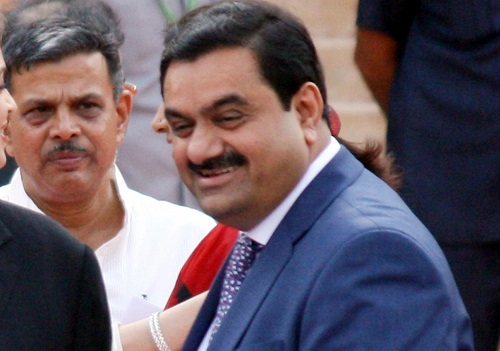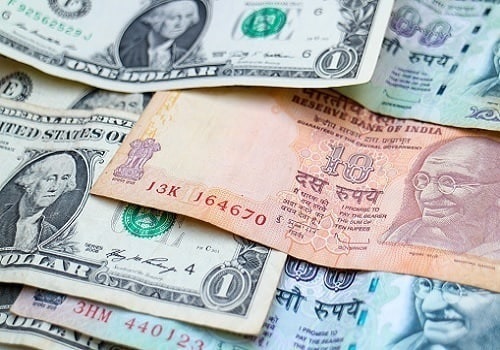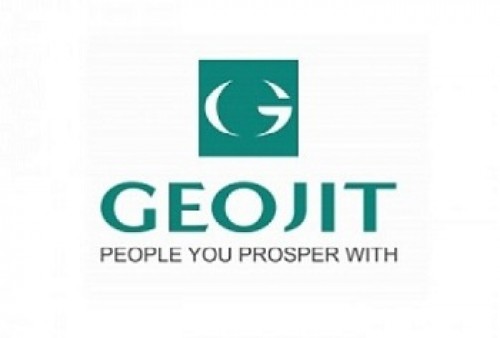Agri Commodity Technical Report 21 September 2022 - Geojit Financial Services

Follow us Now on Telegram ! Get daily 10 - 12 important updates on Business, Finance and Investment. Join our Telegram Channel
SPICES
• Mixed moves were witnessed in NCDEX spices complex on Tuesday. Jeera October futures plunged to six week lows before trimming losses to end the session flat. Fall in production coupled with expectation of rise in festival demand lend support. Turmeric futures too inched up on festival demand prospects though gains were limited on expectation of good crop this season. In the meantime, coriander futures declined.
• As per Andhra Pradesh agricultural department, as on 07th September 2022 Turmeric sowing activity completed around 14,540 hectares as compared to last year same period 14,185 hectares, up by 2.50% till date.
• Production of spices in India is likely to have declined 1.5% on year to 10.9 mln tn in 2021-22 (Jul-Jun), according to data from Spices Board India. The country had produced 11.0 mln tn of spices in the previous year. Among the complex, a major rise in production was pegged in turmeric. The board has pegged turmeric production at 1.33 mln tn, up 18.4% on year. Jeera production was seen at 725,651 tn, down 8.8% on year due to lower acreage in Rajasthan and Gujarat, the key producer. Production of chilli, counted as one of the largest exported and produced spices in the country, is projected at 1.9 mln tn, compared with 2.0 mln tn a year ago. Production of pepper is seen at 60,000 tn, down 7.7% on year, while the output of small cardamom is seen rising by 3.6% on year to 23,340 tn, data showed.
• According to fourth advanced estimates by Gujarat government, jeera production is seen fall by 44.5 per cent to 221500 tonnes in 2021-22 on yoy basis, while that of coriander is seen at 208090 tonnes, down by 5.9 per cent during the same time period.
• Govt. sees spices output in 2021-22 at 10.9 million tonnes vs 10.8 million tonnes.
• The export of spices from India during 2021-22 declined nearly 13 per cent on year to 1,531,154 ton, according to data from the Spices Board India. In terms of value, exports dipped by about 1.25 per cent to 3,057,644.24 rupees. Export of chilli, turmeric, jeera, coriander, fenugreek declined, while that of pepper, cardamom, ginger and fennel rose.
• India exported 153,154 ton of turmeric in in FY 2021-22, down 16.70% on year. Coriander exports were down 15.16% on year at 48,658-ton, data showed.
• The exports of jeera during declined 27.28% on year to 216,996 ton. Export of small cardamom jumped by 63 per cent to 10,572 ton year on, while that of pepper rose 9.5 per cent.
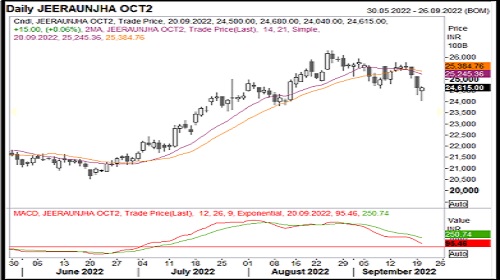
COTTON
• The area under cotton across India in 2022-23 (Jul-Jun) season was over 12.7 mln ha as of Thursday, up 7.5% from a year ago, data from the farm ministry showed. Sowing has been completed in northern states and acreage in Haryana, the top producer in the region, fell 5.4% on year to 650,473 ha. In Punjab, it fell 2.4% to 248,000 ha. Inadequate power supply for irrigationand non-availability of canal water during the initial sowing stage led to a drop in acreage in the northern states, experts said. In Gujarat, acreage rose to 2.5 mln ha as against 2.2 mln ha a year ago. In Maharashtra, the area under the crop increased 7.3% on year to 4.2 mln ha, while in Telangana, it fell 2.2% to 2.01 mln ha. Gujarat is the top producer of cotton in India, followed by Maharashtra and Telangana. Together, Gujarat and Maharashtra account for 50-55% of the country's total production.
• The USDA raises its 2022/2023 projection for cotton world supply to 203M bales, from 202M bales in the August forecast, with ending stocks now projected at 85M bales, up from 83M bales. The US supply is expected at 17.6M bales, up from 16.1M bales estimated last month, with ending stocks at 2.7M bales, up from 1.8M bales in the previous WASDE projection. The report says that higher production is expected in most major producing states. "The season-average price for upland cotton is forecast at 96 cents per pound, 1 cent lower than in August," the report says.
• According to a circular from MCX, the exchange is in process of modifying the Cotton contract specification. Accordingly, with effect from August 29, 2022, no fresh positions will be permitted in Cotton January 2023 expiry contract which has currently nil open interest. Cotton February 2023 expiry and subsequent expiry contracts will temporarily not be launched for trading till such time the revised contract specification is finalized. No changes for other running Cotton contracts with Open Interest.
• The US Department of Agriculture has scaled down its estimate for the global cotton production in 2022-23 (Aug-Jul) to 117.0 mln bales (1 US bale = 218 kg) from 120.1 mln bales projected a month ago. The cut in the estimate is attributed to a lower production in the US, the agency said in its World Agricultural Supply and Demand Estimates report for August. Production in the US is seen lower due to a severe drought, which is likely to affect the yield. Texas, the largest cotton-producing state in the US is likely to harvest 2.9 mln bales of cotton this year, compared to 7.7 million bales in 2021. Production in the US is estimated at 12.6 mln bales in 2022-23, which is sharply lower from 17.5 mln bales a year ago. Global cotton consumption is now seen at 119.1 mln bales in 2022-23, against an estimate of 119.9 mln bales a month ago, owing to a fall in demand from Turkey, Pakistan, Bangladesh, and Vietnam. Global exports are estimated at 44.6 mln bales, against 46.4 mln bales projected a month ago. The agency has lowered its 2022-23 global ending stocks estimate to 82.8 mln bales. For India, the agency has maintained its estimate for production in 2022-23 at 27.5 mln bales. The domestic consumption estimate is seen at 25.0 mln bales. Exports are also maintained at 3.7 mln bales. Cotton ending stocks in India for 2022-23 are now seen at 8.8 mln bales, higher than 8.4 mln bales projected a month ago, it said.
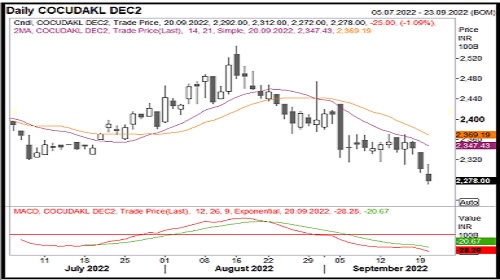
OTHERS
• The Union Cabinet approved sale of 1.5 mln tn chana from its stock to states at a discount of 8 rupees per kg over issue price to help create storage for more central purchases in the upcoming season, a government release said today. This will cost the government 12 bln rupees. To be sure, the cost here means the difference at which the Centre bought chana under price support scheme and the price at which it will sell to states for welfare schemes. The stock procured by states will be used for various welfare schemes such as midday meal, public distribution system and integrated child development programmes. The government has 3.05 mln tn of chana stock and this scheme will help it clear space for purchases under price support scheme and price stabilisation fund, in the coming Rabi season as the production of chana is expected to be good, it said.
• New data released by Statistics Canada recently reveals that Chickpea production in Canada is expected to be around 1.33 lakh tonne, up by 75% from 76,000 tonne same time last year.
• As of 18th Aug '22, According to the Department of Agriculture, Rajasthan, Guar sowing is up by 52.4% at 30.67 Lakh hectare as compared to 20.12 Lakh hectare previous year same period. This season sowing area is high due to early rains and better returns.
• India’s Guar split exports decreased in the month of July’2022 by 32% to 5,882 MT as compared to 8,620 MT previous month. However, the Guarsplit shipments up by 3.92% in July’22 compared to the same period last year. Out of the total exports, around 4,220 MT (71.74%) bought by China, 302 MT (9.98%) bought by USA. : India’s Guar gum exports decreased in the month of July 2022 by 23% to 22,501 MT compared to 29,236 MT during previous month. However, the gum shipments were up by 36.12% in July 2022 compared to the same period last year. Out of the total exported quantity, around 5737 MT (25.50%) was bought by the US, Russia bought 4077 MT (18.12%), China 1,884 MT (8.37%), and Germany 2,270 MT (10.09%). Export demand declined amid correction in crude oil prices. We expect Guar gum export in Aug’22 around 22,000-25,000 tonnes, as WTI crude oil corrected by 9.72% in Aug’22.
• India's natural rubber production in 2021-22 (Apr-Mar) rose 8.4% on yr to 775,000 tn, according to a release by the Rubber Board of India. An increase in yield and tappable area during the year contributed to the rise in production, it said. Area under rubber during 2021-22 was 826,660 ha. The average yield, measured in terms of production per ha of the tapped area increased to 1,472 kg/ha in 2021-22 from 1,442 kg/ha in the previous year. India consumed 1.24 mln tn natural rubber in 2021- 22, an increase of 12.9% from 1.10 mln tn consumed in 2020-21. The auto tyre sector registered 15.9% growth during 2021-22, against 3.2% during 2020-21. Import of natural rubber increased to 546,369 tn during 2021-22 compared with 410,478 tn a year ago due to a gap between the quantity of natural rubber produced within the country and that required by consumer industry, according to the release. Natural rubber production in India will not be sufficient to meet industry demand as consumption is expected to reach 1.5 mln tn by 2025-26.
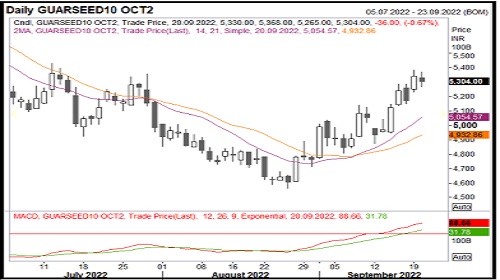
OIL AND OILSEEDS
• India's exports of oilmeals rose 71.4% on year to 282,498 tn in August, according to data released by The Solvent Extractors' Association of India. During the first five months of the financial year that began on Apr 1, exports of oilmeals rose 40.2% on year to 1.5 mln tn. The rise in exports of oilmeals was mainly attributed to the surge in exports of mustard meal that spiked to 1.1 mln tn in Apr-Aug from 542,630 tn in the year-ago period. However, in case of soymeal, exports remained subdued as "India is out priced in the international market," the association said in a release. Exports of soymeal plunged to 108,258 tn in Apr-Aug compared with 155,757 tn a year ago. During Apr-Aug, South Korea imported 452,351 tn oilmeals from India, compared with 308,715 tn a year ago, and Vietnam imported 252,424 tn against 230,483 tn a year ago, the association said. During the first five months of the new fiscal, 610,036 tn oilmeals were exported from Kandla port, and 408,827 tn from Mundra port. Exports from Mumbai port, including Jawaharlal Nehru Port Trust, were at 82,564 tn, while 142,489 tn oilmea ls were shipped from Kolkata port and 287,094 tn from other ports, the association said.
• The global oilseed output is projected to fall 0.2% to 644.8 mln tn for 2022-23 (May-Apr) from 646.0 mln tn projected in August, the US Department of Agriculture said in its September report. A lower output of soybean crop is likely to weigh on the overall production, the agency said. It has projected global soybean output to decline by 3 mln tn month-on-month to 389.8 mln tn for 2022-23. The department estimates soybean production in the US to fall to 119.2 mln tn from 123.3 mln tn the previous month. Soybean production in Brazil is es timated at 149 mln tn, while that in Argentina is projected at 51 mln tn, both unchanged from the agency's August projections. Brazil is the world's top producer of soybean, followed by the US and Argentina. The agency has also scaled down its estimate for soybean's global ending stocks to 98.9 mln tn from 101.4 mln tn estimated in August, with most of the decline in Brazil, Argentina and the US. The estimate for glo bal soyoil production for 2022-23 has also been revised slightly downwards to 61.4 mln tn from 61.6 mln tn predicted in August. However, the estimate for global soyoil exports in 2022-23 has been revised marginally higher to 12.97 mln tn from 12.91 mln tn estimated the previous month.Additionally, the department has projected global soymeal output for 2022-23 at 256.7 mln tn, down from 257.3 mln tn month-onmonth. The agency estimates global exports of soymeal to be a tad lower at 69.98 mln tn compared with 70.14 mln tn pegged the previous month. Soymeal is a derivative of soybean. It is manufactured by crushing the oilseed and is mainly used in producing poultry feed.
• India's soymeal exports in August rose 142.9% on year to 30,000 tn, the Soybean Processors Association of India said today. F or Oct-Aug, soymeal exports plunged to 625,000 tn from 1.9 mln tn in the year-ago period. Soymeal is primarily used as poultry and livestock feed. Indian soymeal is non-genetically modified and considered rich in protein. In August, production of soymeal rose to 519,000 tn from 359,000 tn a year ago, while the output for Oct-Aug was at 5.91 mln tn, down from 7.34 mln tn in the year-ago period, SOPA said. Soybean arrivals in spot markets totalled 600,000 tn in August, up from 200,000 tn a year ago. However, during Oct-Aug, arrivals fell to 8.80 mln tn from 9.23 mln tn in the year-ago period. By the end of August, mills, traders, and farmers were left with around 3.49 mln tn of soybean stock, the association said.
• India's vegetable oil imports rose 33% on year to 1.4 mln tn in August, the Solvent Extractors' Association of India said. The rise was primarily due to a sharp increase in the import of crude palm and crude sunflower oil. During Nov-Aug, the import of vegetable oils was at 11.4 mln tn as against 10.7 mln tn a year ago. The vegetable oil basket consists of edible and non-edible oils. Edible oil imports for Nov-Aug stood at 11.1 mln tn as against 10.4 mln tn in the year-ago period, data showed. The edible oil import basket comprises crude and refined palm oils, crude soyoil, sunflower oil, and mustard oil. There has been no import of mustard oil so far.
• Crude palm oil output in Malaysia rose 9.7% on month to 1.7 mln tn in August, data from the Malaysian Palm Oil Board showed. Export of palm oil in August declined 1.9% on month to 1.3 mln tn, while outbound shipments of biodiesel increased 82.2% on month to 26,244 tn, the data showed. Palm oil is used to manufacture biofuel. Total stocks of palm oil in the country were up 18.2% on month at 2.1 mln tn as of Aug 31.
• The Solvent Extractors' Association of India has written to the Securities and Exchange Board of India, urging for the resumption of futures trade in soybean oil and crude palm oil for risk management and price discovery mechanism, the association said in a release.
• In the ongoing 2022-23 (Jul-Jun) kharif season, farmers have sown soybean across 12.0 mln ha as of Thursday, down 0.2% from a year ago, latest data from the farm ministry showed. Soybean acreage in Madhya Pradesh, the country's top producer, is down 9.0% on year at 5.0 mln ha, while that in Maharashtra, the second-biggest producer, it is up 6.0% at 4.9 mln ha. In Rajasthan, the acreage is up 8.3% at 1.15 mln ha, the data showed.
• The government extended the lower customs duty on edible oils till Mar 31 to cool domestic prices, according to a notification. The decision to soften the duty was taken as prices of edible oils had hit record highs earlier due to lower global production and diversion of vegetable oils for making biodiesel.
• The world's top palm oil producer Indonesia lowered the thresholds for its levies on shipments of the commodity on Wednesday, following a similar move to adjust export taxes. The new levies come into effect on Nov. 1, marking an end to several months where the country waived the tariffs to encourage shipments amid a glut in domestic stock. The new rules charge a maximum levy of $240 per tonne when the crude palm oil reference price (CPO) hits over $1,430 per tonne, the regulations posted on the finance ministry's website showed. Before the levies were waived in mid-July, a maximum $200 tariff kicked in when the CPO crossed $1,500 per tonne. The minimum levy of $55 remains unchanged but will only apply when the CPO reference price is up to $680 per tonne, having previously been up to $750 per tonne. The levies progressively increase thereafter. Indonesia collects levies, on top of a separate palm oil export taxes, to fund its palm oil programmes such as replanting and biodiesel subsidy. Earlier this month, the finance ministry also lowered the threshold for applying export tax on palm oil.
• Indonesia raised its 2022 biodiesel allocation to 11.03 million kilolitres from 10.15 million, following an expectation of rising diesel consumption in the fourth quarter this year, chief economic minister, Airlangga Hartarto, said on Monday. Indonesia has also decided to extend its export levy waiver until Oct. 31. The world's top palm oil exporter has waived palm oil export levy since mid-July.
• The Punjab state government will launch a 'yellow revolution' to boost production of mustard seeds, Jitendra Jorwal, deputy commissioner of the state's Sangrur district, said at an event. The state had organised a meeting of farmers at Sangrur on Saturday to encourage them to diversify from wheat to mustard in the coming rabi season. "Punjab farmers shall diversify crops like mustard from wheat, that will provide double benefits of water conservation and financial support," Jorwal said. Farmers could avail additional financial benefits by registering on modern farms and switching to mustard crop plantation, he said. The 'yellow revolution' would start from Sangrur district and gradually cover the entire state. Through this, the country could save 1.5 trln rupees, which is spent on importing edible oils annually, Ricela Group Chairman A.R. Sharma said. So far, over 200 farmers from Sangrur district have shown interest in joining the mustard mission. A similar project has been launched in Rajasthan and Madhya Pradesh with the help of the Solvent Extractors' Association of India and Solidaridad.
• The government had on Jul 15 issued guidelines to prevent misdeclaration of net quantity on edible oil by manufacturers, packers and importers and to ensure packaging standards, a notification by the Ministry of Consumer Affairs, Food and Public Distribution said. The guidelines have been issued after the Solvent Extractors' Association of India had brought to the ministry's notice how some edible oil companies were packing oil in 1 ltr bottles or pouches at higher temperature and hence offering lesser quantity to consumers. The edible oil companies have also been told to avoid declaring temperature to protect the interest of the consumers as consumers could be fooled when the packaging mentions higher temperature. Manufacturers of Vanaspati, ghee, butter oil and non-edible vegetable oils will also have to mention the volume or weight of the content in the package, the notification said.
To Read Complete Report & Disclaimer Click Here
For More Geojit Financial Services Ltd Disclaimer https://www.geojit.com/disclaimer
SEBI Registration Number: INH200000345
Views express by all participants are for information & academic purpose only. Kindly read disclaimer before referring below views. Click Here For Disclaimer














